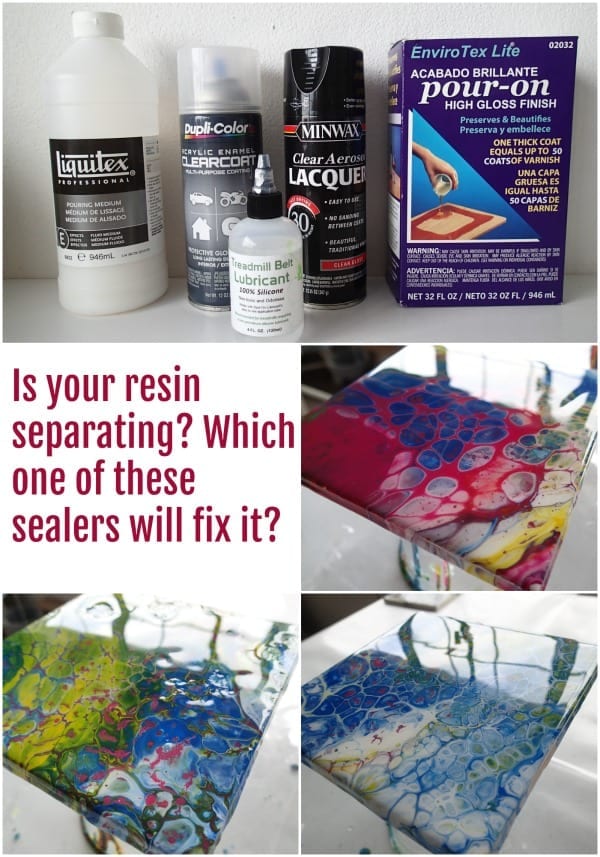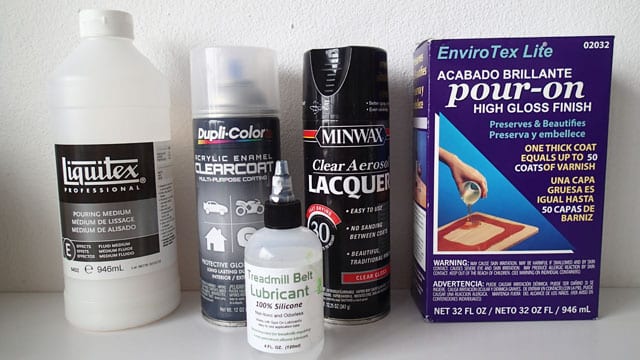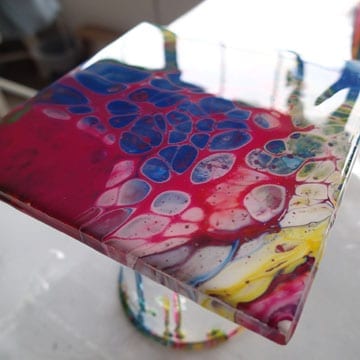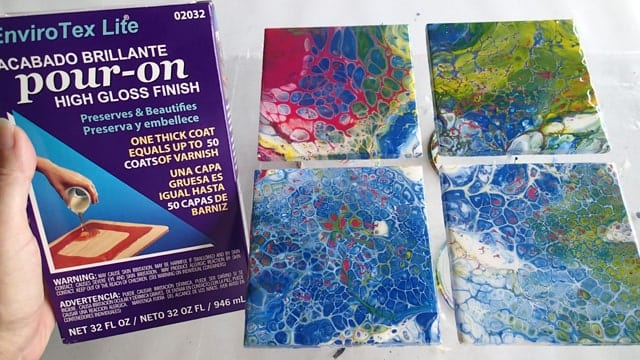A recent accident got me to thinking. I was rushing to get some paintings finished, and I sprayed them with a couple of my spray varnishes I had and then immediately got very concerned because I had forgotten to clean off the silicone! Would they be ruined?

There was nothing I could do except wait for them to dry and see what happened. Nothing happened. They were fine. The silicone hadn’t created any problems with the varnish. So this got me to thinking. Maybe spray varnishes apply differently to the brushed on varnishes and aren’t so easily affected and separated by any silicone oil left on the surface. I went ahead and sprayed on more layers, still without cleaning and all was just perfect. Just the same as if I had fastidiously cleaned them. Is this a breakthrough? What did it mean?
Did it mean that if I used a spray on sealer, I could seal my paintings and tiles without taking the time to remove the oil? That could be a great time saver. Could I then apply a spray sealer first to ‘block’ in the oil and then go ahead and use my lovely Polycrylic brush-on varnish over the top and still get a perfect finish? I had to test it!

Materials used in this project:
Existing 4 test tiles with silicone from this video
Liquitex Pouring Medium
Minwax Clear Aerosol Lacquer
DupliColor Acrylic Clearcoat
Envirotex Lite resin
So in this video I am going to try to resin these 4 tiles that I had created especially for this test, using treadmill belt silicone oil in all of the colors. I’ll explain more in the video about how I prepared each tile and then we will see what happens if I apply resin, which is notorious for creating craters and voids if even the slightest bit of oil is present.
Hmm, ok so perhaps the idea was a good one, and there may be a product out there that would work. The Liquitex Pouring Medium was almost perfect. Perhaps if I did a thicker or second coat. I’ve heard mention that Art Resin recommend using the Golden Self Levelling Gelas a sealer before your coat of resin, but I don’t have access to that to test it. I hope someone out there will give it a try and let us know if there is a fool-proof way of using resin or varnish on our pours without getting those disappointing bare spots where it separates.
I was able to get a perfect finish on the cleaned one and the one with the pouring medium just by adding a drop of silicone oil to my finger tip and rubbing it around in the resin until everything smoothed out and I got good coverage. However I do feel that adding the oil to the resin gives it just the tiniest of a cloudy appearance and I’d like to avoid that if I can. Anyone else got any ideas? Or anyone had any success?
After being told in high school that she was so bad at art that she should switch to another subject, Deby didn’t paint again for 35 years. Then a stroke released a new wave of creativity and she began exploring with dot painting, abstract and eventually acrylic pouring, and at last the joy of working with color returned. You don’t need ‘talent’ to be an acrylic pouring artist – just enthusiasm, some basic instruction, and a willingness to try, fail and try again. Paint along with her and learn from her many mistakes, and you’ll soon make great art together.







I have done two vinyl LP’s that I wanted to make into clocks. I love the pourings but after applying the resin to them I had bare spots which was so disappointing. Once they are dry is there anything I can do about it or do I just have to live with it? I did not wipe them down before pouring the resin. Was that the cause? Would love help on this. Thank you in advance.
Ah yes, you really need to clean off any oil and grease well before applying resin. But all is not lost. If you give them a good clean now, you can apply another layer of resin over the top and it won’t even notice that there was a problem in the first layer.
Thanks Deb. I already tried putting a second layer without wiping down. Can I clean it and do a third?
Sure you can 🙂 Third time is the charm I hope. And its all good practice
Thanks for taking the time to reply so quickly. Your the best. Love your videos too.
You can pour a second coat. Sand the surface first to give the second coat a place to grab onto the first coat. I sand the craters and dips especially. Re-clean the surface with a mixture of Windex, alcohol, and Dawn and wipe. Usually the second coat comes out fine. However, with great cleaning before the first coat and a watered down gel coat, the resin should go on well.
What’s the best way to clean off the silicone?
I have a quick step by step tutorial on how I do that here Pauline.
I followed that thread and was wondering…why use non talc powder? Is regular corn starch ok to use for removing silicone?
Sure, corn starch is fine. I just like the baby powder because it comes in a handy shaker container and smells nice 🙂
Maybe it isn’t the silicone under the sealers that caused the resin not to stick to some areas. Maybe there is an incompatibility with those products and the resin. Spray finishes have a particular chemical that helps propel them from the can. I know that because if that, spray finishes cannot be used with polymer clay. It does look like Liquitex pouring medium is the most promising. Thanks for doing the experiment and letting us all see your results!
Yes I think if I had cleaned and then used the pouring medium as an isolation coat it would have been perfect. I was really putting it to a test by not even cleaning it first.
Hi, everyone, had a terrible time with the resin not sticking, so I contacted the manufacturer and they told me to use Golden Clear Leveling Ge, IT WORKS!! No more resin holes, or fisheyes, hope this helps. You do need to wait 24 hours for it to dry, but it was worth it to me.
Thanks for sharing this Colleen, glad it worked. Super helpful!
Great reading! Thanks for sharing your trial and error tips. Good to know all this as I have started working with resin and I want to try resi-blast or something silicone for cells. I didn’t realize how important wiping was!
Last December I made about 60 coasters using ceramic tiles and acrylic pour. I worked carefully to clean the tiles – some with cornstarch, some with Dawn dish soap and others with both. Even so, when I poured the resin, almost all of the tiles showed the separation from the silicone in one or more spots. I was at my wits’ end as I wanted to give these as Christmas gifts and I didn’t have more time to make new ones. I searched for ideas to remedy my problem and found a video (I’m sorry, I don’t remember the woman’s name) who said to sand the resin down a bit, then take some mineral water (like Perrier) on a paper towel and clean the tile and the oil spots with the mineral water and then re-apply resin. I did that and to my surprise, it worked on almost all of the tiles! I couldn’t believe how much the mineral water helped!
I’ve wondered since then if I could just rinse the tiles with silicone with the mineral water without cleaning the and whether the resin would have good coverage, but I haven’t had a chance to try that. I DID try Deby’s approach by pouring a coat of Liquitex Pouring Medium onto some of the tiles and that also helped quite a bit, but I did still end up with some divots from the silicone.
I hope someone has found a way to get good resin coverage without having to go through the disappointing labor of cleaning canvases and tiles as thoroughly as possible, only to still end up with divots after applying resin!
Hi I’m very new to paint pouring and I didn’t know about the cleaning part but have sprayed with a sealer can I still clean them and reseal them thank you
I get a fairly smooth finish with polyurethane (Flecto Varathane) and acrylic floor gloss), but not the deep, hard gloss of epoxy resin. I’ve been wondering if I could use one of these as the first layer, then pour a coat of resin over that. I swiped resin over a small area of polyurethaned tile and it dried smooth, but I don’t know yet if chemically the combo will hold up over time.
Another thing I want to try is baking the painted tile before adding a sealer. With polymer clay, at least, baking seems to adhere the paint better to the clay. I’m curious what effect it might have on any silicone that’s in the paint.
I know when I’ve used the silicone drops with my medium it left after resining with craters. Makes me kind of not want to use silicone ugh
Creating charcouterie boards for presents. Only used Floetrol as my pouring medium with acrylic paint. No silicone! What is the best way to clean pours to wipe any oils before resining. I have baby wipes , alcohol 91% . How long do you wait before resining?
Thank you .. Lynn V.